Living in Michigan and saw some big birds but are not sure which ones they were?
Michigan is known for its wildlife. According to the Michigan Bird Records Committee (MBRC), there are over 450 species of birds there. And just like in Florida, Pennsylvania, and Texas, there is plenty of those that can grow up to impressive sizes.
The list of big birds in Michigan includes Caspian terns, great horned owls, sandhill cranes, great blue herons, great egrets, bald eagles, turkey vultures, trumpeter swans, and many others.
The largest bird in Michigan is the all-white Trumpeter swan with a length of up to 5 ft 11 in and a wingspan of up to 8 ft 2 in. It is the largest extant species of waterfowl and both the heaviest and longest native bird of North America.
Some of these Michigan’s enormous birds, like the great horned owl and the great blue heron, can be seen year-round in the state, while others, like the Caspian tern, common loon, and osprey, will spend only summers there.
Table of Contents
Large Birds In Michigan
Pileated Woodpecker

Scientific name: Dryocopus pileatus
Lifespan: 12 years
Wingspan: 26-30 in
Length: 16-19 in
Weight: 7.9-14.1 oz
Range In Michigan: Year-round resident in most of Michigan
Pileated woodpeckers are the largest woodpeckers found in Michigan. They breed in the forests of Canada, the Eastern USA, and on the Pacific coast.
The word “pileated” comes from the Latin word “pileatus” which means “capped” – pileated woodpeckers are primarily black with a prominent red crest on their heads.
They also have white lines on their throats and white on their wings. Males also have red lines on the side of their heads; this is absent in females.
Look for them hitting dead trees in pursuit of ants and making rectangular holes in the process. These black and red woodpeckers are omnivores that feed on insects (especially carpenter ants), fruits, nuts, and berries.
They are rare around bird feeders; the only way they visit them is if the winter is extremely cold. Try to attract pileated woodpeckers to your backyard by adding suet to your feeders, leaving dead trees for them to forage or roost there, or putting up a nest box to attract a breeding pair. Pileated woodpeckers are crucial for making tree holes that other bird and animal species use to nest.
Fun Fact: The famous cartoon character, Woody Woodpecker, is said to have been based on pileated woodpeckers.
Caspian Tern

Scientific name: Hydroprogne caspia
Lifespan: 12 years
Wingspan: 50–57 in
Length: 19–24 in
Weight: 1.1-1.72 lb
Range In Michigan: Summer resident around the shores of Michigan
The Caspian tern is the largest tern in Michigan and the world. Although it can be seen in the state from mid-April through September, the optimal time to look for this large bird is during May, June, and July.
It is currently listed as a State Threatened species with several colonies found nesting in eight counties in Michigan (Alpena, Alcona, Arenac, Bay, Charlevoix, Delta, Emmet, and Mackinac counties). The highest numbers are found on small islands at the end of the Garden Peninsula and in the Beaver Archipelago.
Caspian tern is easily recognizable by its large head, coral red beak, shallowly forked tail, and deep, raspy call. It also has white color overall with pale gray upperwings.
It nests on the open sandy or pebble beaches, usually on islands in large bodies of water.
This large bird got its name from the early associations with the Caspian Sea where Caspian terns are fairly common even today.
These large terns are very aggressive when defending their breeding colony. They will pursue, attack, and chase away potential predatory birds, and even bite people on their heads if they invade their space.
Caspian terns will hover high over the water, scanning for fish. When they spot one, they will fly down rapidly and dive to catch it. They also occasionally feed on large insects, the young and eggs of other birds, and some rodents.
Rough-legged Hawk
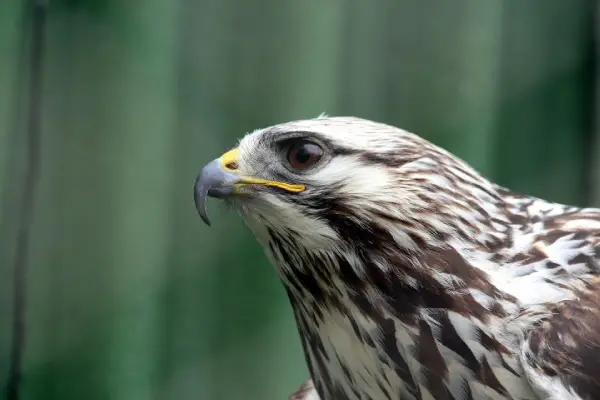
Scientific name: Buteo lagopus
Lifespan: 15 years
Wingspan: 47-60 in
Length: 18-24 in
Weight: 1.3-3.6 lb
Range In Michigan: Winter resident throughout Michigan
Rough-legged hawks or rough-legged buzzards are large birds of prey found in Europe, Asia, and North America. Females are bigger than males and weigh from 2.3 to 2.8 pounds; males are 1.8 to 2.2 pounds heavy.
In Michigan, they are one of the largest hawk species and can be seen during the non-breeding season, from November to April, before migrating north in May.
These long-winged raptors are common around fields and marshes; they come in different morphs. Light morphs have pale plumage with dark bellies and dark “wrist” patches while dark ones are brown-black with white flight feathers.
They were named after their feathered legs that help keep them warm in the Arctic regions. They also love to hover by beating their wings quickly, just like kestrels, osprey, and kites.
Rough-legged buzzards have small talons which explains why they mostly hunt small mammals.
They have an interesting adaptation for locating their prey – rough-legged hawks have UV vision.
Some small mammals, like voles and mice, leave trails of urine as they move. Those urine trails reflect ultraviolet light – rough-legged hawks see them glowing bright yellow which helps them locate their next meal and highlight hunting areas with high prey densities.
They nest in trees and cliffs, lay 1-7 bluish-white eggs with brownish spots, and males feed the females as they incubate the eggs – the species is monogamous.
Great Horned Owl

Scientific name: Bubo virginianus
Lifespan: 15-25 years
Wingspan: 35.8-60.2 in
Length: 17-25 in
Weight: 2.7-3.5 lb
Range In Michigan: Year-round resident throughout Michigan
Also known as the tiger owl, the great horned owl is one of the largest owls found throughout Michigan. It is also among the largest owls in North America and lives in mountains, grasslands, conifer forests, deserts, chaparrals, and many other habitats.
The great horned owl has the most diverse diet of all North American raptors.
An aggressive and excellent hunter, this big bird feeds on rabbits, hares, rats, mice, voles, other small mammals, larger mid-sized mammals, reptiles, amphibians, and invertebrates.
It might occasionally even attack larger prey, including raptors such as Ospreys, Peregrine Falcons, Prairie Falcons, and other owls.
They hunt using their acute hearing and excellent eyesight and can fly in near silence to catch their prey by surprise.
In case you see a great horned owl in person, you will notice long, earlike tufts, intimidating yellow eyes, and a deep hooting call. It has a gray-brown plumage with a mottled pattern and a white patch at the throat.
These large nocturnal owls are monogamous and may stay together for over five years, sometimes even for a lifetime.
These owls are also one of many bird species found in Western Pennsylvania.
Great Gray Owl
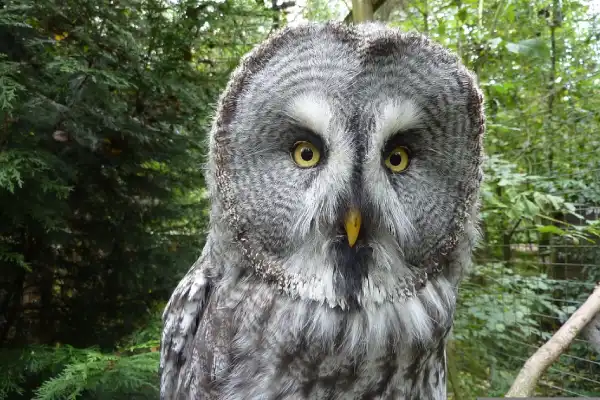
Scientific name: Strix nebulosa
Lifespan: up to 27 years in captivity
Wingspan: 56-60 in
Length: 24-33 in
Weight: 1.2-4 lb
Range In Michigan: Winter resident in Upper Peninsula and northern parts of Lower Peninsula Michigan
Great gray owls are the largest species of owls in the world by length and measure from 24 to 33 inches long. They are known under several names, including Phantoms of the North, bearded owls, sooty owls, etc.
Great gray owls are non-breeding residents of Michigan that mostly live in the forests along the Great Lakes in the north. Patterned with brown and white mottling, streaks, and barrings, great gray owls blend perfectly with the gray-brown bark of their conifer perch. They also have large yellow eyes on their large round heads.
Great gray owls are a very rare species that hunt around dusk and dawn, mostly on voles. Although mostly silent, solitary, and stealthy, these raptors have been known to drive off predators as large as black bears when defending their nests. They are the most vocal during the breeding season with males defending their territories with deep “hoos“.
They are nocturnal; read about other animals that are active during the night in Michigan on this link.
Gyrfalcon
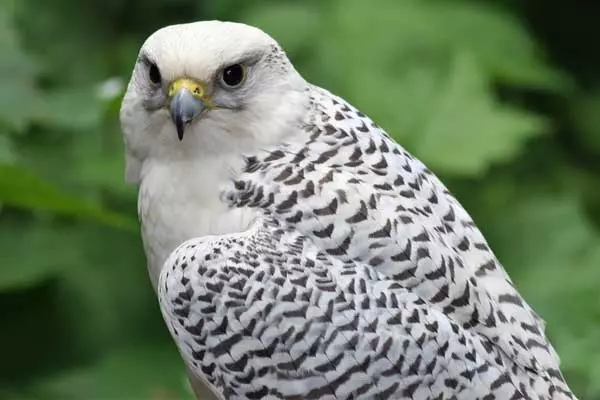
Scientific name: Falco rusticolus
Lifespan: up to 20 years
Wingspan: 43-63 in
Length: 19-24 in
Weight: 1.77-4.6 lb
Range In Michigan: Winter resident in Michigan’s Upper Peninsula and Northern Lower Peninsula
The largest falcon in Michigan, the gyrfalcon can be seen during winter in the state.
If you decide to go searching for them in Michigan, you are most likely to see one of these birds in Sault Ste Mairie – gyrfalcons have been seen in the Lower Peninsula as well, but these are much rarer occurrences. Look for them from October to January in open fields, coastlines, dunes, prairie, and shrubsteppe.
Gyrfalcon is nearly the size of a Red-tailed Hawk and has an impressive wingspan of up to 63 in. It is a large bird of prey in Michigan that can range in color from white to silvery-gray to dark sooty-brown. Females are bulkier and larger than males.
During medieval times, the gyrfalcon was considered a royal bird, highly valued as a hunting bird.
Its only predator is the golden eagle, but in most cases, it will avoid these formidable falcons. On the other hand, the gyrfalcon’s prey includes the ptarmigan and waterfowl, which it may snatch during flight, some fish, and mammals.
These falcons are monogamous and stay together until one of the birds dies.
Read More: More examples of white-headed falcons
Common Loon
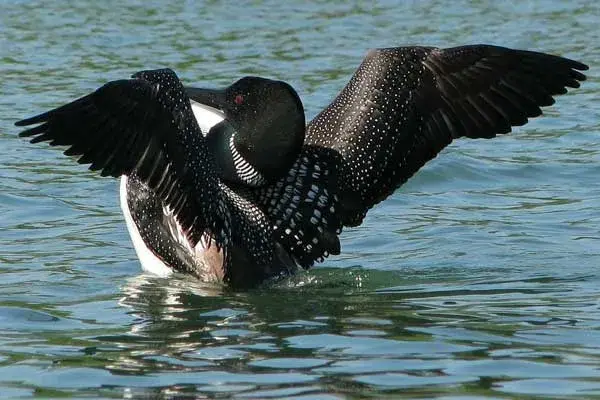
Scientific name: Gavia immer
Lifespan: 20-30 years
Wingspan: 50-57.8 in
Length: 26-36 in
Weight: 4.9-16.8 lb
Range In Michigan: Summer resident in Michigan’s Upper Peninsula and Northern Lower Peninsula
The common loon or the great northern diver is the largest species of loon found in Michigan.
It breeds mostly in the Upper Peninsula and the very northern portions of the Lower Peninsula. There is a very small population in the southern portions of the Lower Peninsula.
Loons usually arrive in Michigan around April and begin preparing their nest in May. They are listed as a threatened species in Michigan and according to the Michigan Breeding Bird Atlas, there are 500 to 775 breeding pairs in the state.
This large diving waterbird is easy to spot by its rounded head and dagger-like beak. The common loon is famous for its eerie, beautiful calls (the wail, tremolo, yodel, and hoot).
During summer, adults have black heads and bills, white breast color, and black-and-white spots on their backs. By the time these loons reach south, the dramatic black and white colors will change into a winter plumage of dull dark gray with white on the front of the neck and breast.
Common loons are excellent divers that can stealthily submerge without a splash to catch fish. They can go over 200 feet below the water’s surface, stay there for up to 5 minutes, and swallow their prey underwater.
Common loons mostly feed on fish, crustaceans, insect larvae, mollusks, and occasionally aquatic plants.
They are monogamous and the pair may breed together for a decade or more. Both the male and the female will often together defend a territory.
The common loon is a state bird of Minnesota, a provincial bird of Ontario (Canada), one of 5 species of loon found in Canada, and one of the two species of loons found in Michigan.
Osprey

Scientific name: Pandion haliaetus
Lifespan: 15-20 years
Wingspan: 50–71 in
Length: 19.7-26 in
Weight: 2-4.6 lb
Range In Michigan: Summer resident in most of Michigan
Ospreys are very large birds found during summer in most parts of Michigan, except in the Tri-cities region, where they can be seen while migrating. On their way from South America, they come to the state to breed when they are two years old. First to arrive are the males.
Look for them perching around telephone poles, cell phone towers, and light posts.
They spend their entire first year in their southern wintering ranges. When they’re ready to give parenting a try they will head north.
Ospreys are large birds of prey in Michigan that can reach 26 inches in length and 71 inches across the wings. They have brown upperparts and predominantly white heads and underparts.
What is unusual for ospreys is that they have a reversible outer toe that allows them to grasp with two toes in front and two behind. Such adaptation prevents fish from slipping away.
They are also known as “sea hawks” or “fish hawks” and will hover above the water, locate their prey and then swoop down for the capture with their talons extended.
Ospreys are piscivorous and fish makes up 99% of their diet. During their 20-year-long lifetime, these migratory birds can travel over 160,000 miles.
Read More: Examples of white-headed hawks
Glaucous Gull

Scientific name: Larus hyperboreus
Lifespan: 15-20 years
Wingspan: 52-67 in
Length: 22-30 in
Weight: 3-3.4 lb
Range In Michigan: Winter resident around Michigan’s lakes
The glaucous gull is the second-largest gull in Michigan. This big bird has a deep chest, a heavy beak, and a large head that makes the eye appear small. You will recognize it by the pale gray plumage, a yellow beak, and all-white wingtips.
Glaucous gulls are significantly larger than the Iceland gulls and slightly smaller than the great black-backed gulls.
They are omnivores that feed on almost anything, from fish, insects, and mollusks, to small birds, small mammals, carrion, and plants.
Great Black-backed Gull

Scientific name: Larus marinus
Lifespan: up to 27 years
Wingspan: 59-66.9 in
Length: 25–31 in
Weight: 1.65-5 lb
Range In Michigan: Winter resident around Michigan’s lakes
Often described as “the king of the Atlantic waterfront”, the great black-backed gulls are very aggressive hunters, pirates, and scavengers.
They are the largest gulls in Michigan and throughout the world.
Great black-backed gulls are present all year in most parts of their northern breeding range and when the winter comes, some populations will migrate to spend the winter around the shores of Michigan.
You will recognize these enormous gulls by their white heads, necks and underparts, dark grey wings and backs, pink legs, and yellow beaks.
Because of their size and omnivorous feeding habits, these birds will prey on other birds during the nesting season.
Great black-backed gulls feed on carrion, fish, mollusks, crustaceans, marine worms, insects, rodents, and berries. They are apex predators that also eat adults, young, and eggs of other birds.
Great black-backed gulls were hunted for their feathers that were used to make hats in the past. As a result, this species got eradicated from large parts of its range.
Today, however, due to their adaptability to humans, the great black-backed gulls increased in numbers and became widespread – in some areas they are now even considered pest species.
Turkey Vulture
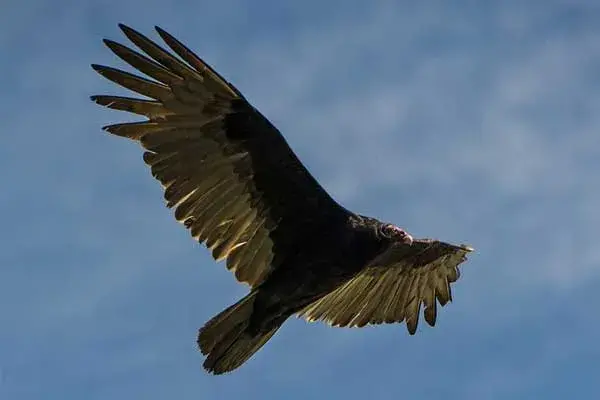
Scientific name: Cathartes aura
Lifespan: 16 years in the wild
Wingspan: 63–72 in
Length: 24–32 in
Weight: 1.8-5.3 lb
Range In Michigan: Summer resident throughout Michigan
This is the most widespread of the New World vultures and the largest vulture in Michigan.
Turkey vulture will spend the warmer months in the state, but in the winter it will migrate south for warmer temperatures and no snow.
It got its name due to its resemblance to a wild turkey.
Turkey vultures are a familiar sight in the sky over the entire state during summer. You will recognize them by their bald heads, dark plumage, and long, broad wings.
These birds have an impressive wingspan of around 67.5 in and are bigger than other raptors, except eagles and condors.
They have a huge range and an estimated population of over 18 million birds. Look for them in the open areas including mixed farmland, forest, and rangeland.
Turkey vultures are also very social birds that roost in large community groups that can include several hundred individuals.
They have extremely strong stomach acids which allow them to eat and digest carcasses tainted with anthrax, tuberculosis, and rabies, without getting sick.
Their diet mostly includes carrion and human garbage located through the use of smell, although they might occasionally catch live prey, including young or sick birds and mammals.
You might see them sit in trees on the sides of roads in Michigan waiting for their next meal.
They might be big and look scary, but turkey vultures actually do a great service across the US. by removing dead animals and preventing the transmission of any diseases those dead animals could have carried.
Great Egret

Scientific name: Ardea alba
Lifespan: 22 years
Wingspan: 52-67 in
Length: 31-41 in
Weight: 1.5-3.3 lb
Range In Michigan: Summer resident in southeast Michigan
This impressively large bird has a huge wingspan of up to 67 inches and can be found during summer in southeastern parts of Michigan, around wetlands and other areas of water.
They arrive in Michigan around July and stay there through October.
Great egrets are one of the biggest birds found in the state and are easy to recognize by their all-white plumage, long yellowish-orange beaks, and long black legs.
These members of the heron family are the second largest in North America with only the great blue heron being larger.
Hunted for their beautiful plumes called “aigrettes” that were used as hat decoration in the 19th century, great egrets almost became extinct. Thanks to several laws and conservational measures, their numbers have since recovered.
They are similar to pelicans because of their white plumage; great egrets can also tuck their necks right into their backs during flight.
They are seasonally monogamous (stay with the same partner for one breeding season) and breed in colonies in trees close to large lakes.
A male great egret will display its mating season plumage and colors and point its beak upward to attract a female.
Great egrets will slowly stalk their prey or stay motionless, waiting for the right moment to strike and impale prey with their long, sharp bills. They forage in shallow water or drier habitats and mostly feed on fish, frogs, small mammals, small reptiles, crustaceans, and insects.
Snowy Owl
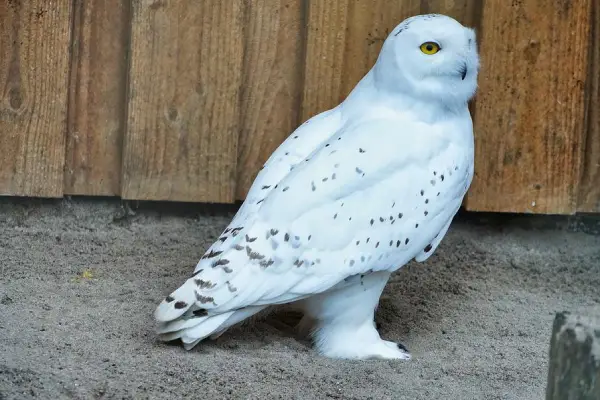
Scientific name: Bubo scandiacus
Lifespan: 10 years in the wild and 28 years in captivity
Wingspan: 45.7-72 in
Length: 21-28 in
Weight: 2.9-6.5 lb
Range In Michigan: Winter resident throughout Michigan
Snowy owls are enormous white birds of prey. They are the heaviest owls in North America and have a longer wingspan than any other owl found there.
Because of the cold weather in the Arctic regions they inhabit, snowy owls need good insulation; even their feet are covered with feathers! This resulted in them being one of the heaviest owls in the world, reaching up to 6.5 pounds.
Females are larger than males and span up to 6 feet across the wings. They are the only white owls in the world and males tend to be whiter than females; both have some black or brown markings on the body and wings and yellow eyes.
Snowy owls are native to the Arctic region of North America and breed on the tundra. In Michigan, they can be seen during winter statewide.
They are very vocal birds with over 15 different calls. The most common call consists of 2-6 rough notes that sound like “krooh-krooh” and can be heard for miles. They might also make some rattle “rick-rick-ha-how-quock” calls.
Snowy owls are diurnal birds that sleep during the night and hunt during the day, especially when the summer comes; their diet includes small mammals, some water birds, fish, and even carrion.
Their favorite food is lemmings (small mouselike rodents) – they might hunt as much as 1,600 of those per year.
Snowy owls are monogamous and mate for life. A female will lay 3-11 eggs in the nest on the ground. The male will feed her while she incubates the eggs for around a month.
Canada Goose

Scientific name: Branta canadensis
Lifespan: 10-24 years
Wingspan: 50-73 in
Length: 30-43 in
Weight: 5.7–14.3 lb
Range In Michigan: Summer resident in Upper and Northern Lower Peninsula and a year-round resident in southern Michigan
This large wild goose has a black head and neck, white cheeks, white under its chin, and a brown body. Michigan is home to over 330,000 Canada geese – some of them will stay year-round while many will spend only the summer there.
Their numbers increased from 9,000 in the 1970s to over 300,000 in 2017 in Michigan. And their popularity has been on a decline in the state.
These big, unique-looking, and messy birds tend to visit the areas humans created for themselves ( lawns, parks, beaches, golf courses) fouling waterways and leaving piles of green droppings everywhere.
They breed in urban and cultivated habitats with lots of food and few natural predators.
There are 7 subspecies of Canada goose – one of them, the giant Canada goose (B. c. maxima), is the largest goose in the world.
Canada geese are known for flying in a distinctive V-formation and series of loud “honks” calls.
Sandhill Crane
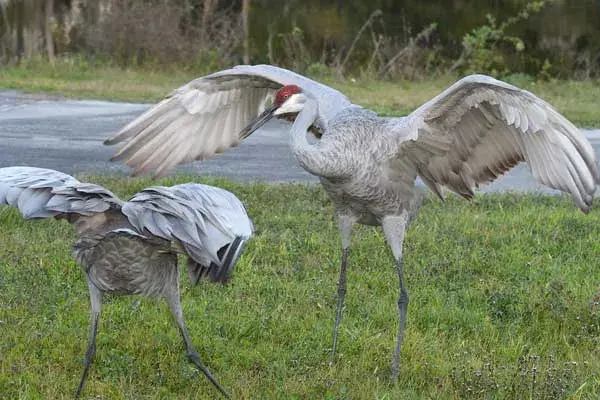
Scientific name: Grus canadensis
Lifespan: 20 years
Wingspan: 78.7 in
Length: 47.2 in
Weight: 6-14.8 lb
Range In Michigan: Summer resident throughout Michigan
Sandhill cranes are very big, tall birds with long necks and legs, and very broad wings. These large birds in Michigan with red heads have a truly unique look.
Sandhill cranes can be identified by their mostly slate gray plumage, rusty washes on the upperparts, pale cheeks in adults, red head patches, and black legs.
Of the many giant birds in Michigan, sandhill cranes are also one of the most striking. With a wingspan of almost 7 feet, a height of 4 feet, and an average weight of 10 pounds, these beautiful birds are just slightly smaller than their endangered cousin, the whooping crane.
Sandhill cranes are fairly social birds and can usually be found in pairs or family groups throughout the year. They are also monogamous and mate for life, staying together for years, until one of the cranes dies.
In Michigan, sandhill cranes will begin nesting in April or May, around marshes and bogs. In October and late November, they will leave the state and begin migrating south.
Their diet mostly consists of plant material, including waste grain, roots, berries, nuts, some insects, and snails.
Sandhill cranes are also found in Colorado; read more about that state’s largest birds here.
Golden Eagle

Scientific name: Aquila chrysaetos
Lifespan: up to 30 years
Wingspan: 70.8-90.1 in
Length: 26-40 in
Weight: 7.9-11 lb
Range In Michigan: Migrating through Michigan
Michigan is lucky to get occasional visits from one of North America’s largest eagle species, the golden eagle. They do not nest in the state.
There are two times when golden eagles can be spotted in Michigan: during fall and spring migration.
The best chance of seeing them is from late October to mid-November, during their fall migration.
They are one of the largest, fastest, and most agile birds of prey in North America and can be identified by the overall dark brown plumage, with the lighter golden-brown color of their napes.
Their agility and speed together with powerful feet and large, sharp talons allow them to hunt rabbits, hares, ground squirrels, and prairie dogs.
We also have a list of Michigan’s smallest birds, check it here.
Bald Eagle

Scientific name: Haliaeetus leucocephalus
Lifespan: 20-30 years in the wild
Wingspan: 70.8-90.5 in
Length: 28-40 in
Weight: 6.6-13.9 lb
Range In Michigan: Summer resident in Upper and Northern Lower Peninsula and a winter resident in southern Michigan
One of the largest and most iconic birds of North America, the bald eagle is a bird of prey easily recognized by its commanding presence, white head and tail, brown plumage, and bright yellow beak.
This enormous bird can be found throughout the year in Michigan. During summer, the bald eagle can be seen in the Upper and Northern Lower Peninsula; in winter, they nest in southern parts of the state.
After recovering from 75 pairs in 1970, bald eagles are now doing very well in the state and are a common sight around lakes, rivers, and wetlands of Michigan.
According to the U.S. Fish and Wildlife Service, there are over 850 bald eagle nests in Michigan, present in 81 of the state’s 83 counties.
Bald eagles are carnivores and opportunistic feeders that mostly consume fish, which they snatch from the water with their talons.
These birds are hard to miss as they soar through the air with their 7.5-foot-wide wingspan.
Bald eagles build the largest nests of any North American bird and the largest tree nests ever recorded for any animal species. Their nests can be up to 13 ft deep and 8.2 ft wide.
Read More: 12+ biggest birds of Ohio
Great Blue Heron
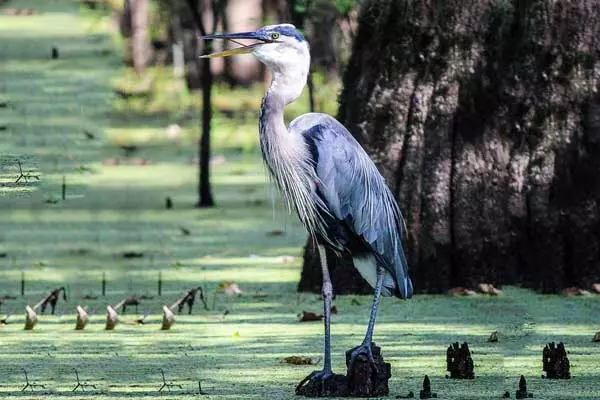
Scientific name: Ardea herodias
Lifespan: 15 years
Wingspan: 66–79 in
Length: 36–54 in
Weight: 4.0-7.9 lb
Range In Michigan: Year-round resident throughout Michigan
The largest of North American herons and one of Michigan’s largest birds, the great blue heron is easy to identify by its long yellow-orange bill, short black plumes on its head, and black and chestnut pattern on the shoulders.
Great blue herons are scattered throughout most of Michigan; you are most likely to encounter one in the southern half of the state or the Upper Peninsula. Some populations of herons will migrate south to Central America or the Caribbeans.
They are quite common along the edges of rivers, lakes, and wetlands. During the flight, they will hold their necks in an S-shape with legs trailing behind.
Despite their large size and stocky build, great blue herons are fast birds that can reach speeds of around 30 mph.
They are monogamous only for a single season and will go through some interesting courtship rituals, locking and rubbing their bills on the feathers of the other bird before mating. Both parents will take turns in incubating the eggs, and after hatching, the chicks can fly at only 2 months of age.
They nest in colonies called heronries that can occasionally have more than 500 nests.
Great blue herons are carnivores that feed on fish, amphibians, reptiles, invertebrates, small mammals, and even other birds. These birds will slowly stalk their prey in shallow waters, striking with lightning speed, catching them with their long and sharp beaks.
Read More: 14 birds in Pennsylvania that are blue
Mute Swan

Scientific name: Cygnus olor
Lifespan: up to 10 years in the wild
Wingspan: 79-94 in
Length: 49-67 in
Weight: 18.7-32 lb
Range In Michigan: Year-round resident in the Lower Peninsula
Mute swans are large swan species that were introduced to North America in the late 19th century.
They were named “mute” for being less vocal than other swan species, but still produce a variety of hisses, bugles, and other sounds.
They measure up to 5 ft 7 in long, span 7 ft 10 in across the wings, and weigh up to 32 pounds. Identify mute swans by their all-white plumage, orange beaks with black borders, and pronounced knobs on top of their beaks.
Mute swans are common year-round around wetland areas including marshes, lakes, parks, and ponds in the Lower Peninsula. They were brought to Michigan in 1919 and soon established a feral population in the state.
These aggressive, territorial, and invasive swans will fight with the native trumpeter swans on Lake Erie marshes and other locations, pushing them out of their nesting area.
Due to their large numbers and negative effect on other waterfowl and vegetation, they are considered invasive species. Mute swans are omnivores that feed on aquatic vegetation, aquatic insects, fish, and frogs.
Read More: What are some of the largest birds found in Illinois?
Trumpeter Swan

Scientific name: Cygnus buccinator
Lifespan: up to 25 years
Wingspan: 72.8-98 in
Length: 54.3-70.8 in
Weight: 15–30 lb
Range In Michigan: Summer resident in southwestern Michigan and parts of the Upper Peninsula
Trumpeter swans are the largest swans in Michigan and North America.
Although once widespread in the Great Lakes region, these huge birds were hunted down and wiped out in Michigan 100 years ago. Thanks to conservation efforts, according to some estimates, there are over 3,000 trumpeter swans in Michigan today.
You will best identify trumpet swans by their white plumage and black bills. They are big birds, North America’s heaviest flying birds that can weigh over 25 pounds.
With a wingspan of up to 98 inches, a length of almost 71 inches, and a weight of up to 30 pounds, trumpeter swans are the largest birds in Michigan.
Some people mention Sandhill cranes as Michigan’s biggest – if you compare the two, you will see that trumpeter swans are longer, have a bigger wingspan, and weigh almost twice as much as sandhill cranes.
Trumpeter swans are loud birds and their calls sound similar to a trumpet, which resulted in the specie’s name.
They are mostly vegetarians and mainly eat plants found in or near the water. Occasionally they will eat insects, small fish, and eggs, but trumpet swans prefer plants overall.
Read More: List of Michigan’s songbirds
Summary
This concludes our list of large birds in Michigan.
There is plenty of large birds in Michigan, including cranes, eagles, owls, geese, vultures, gulls, and others.
Michigan has large areas of different natural habitats that make great homes for a wide range of bird species.
Next time, should you see these birds in person, you should be able to recognize any of them with ease!
And if you enjoyed our article, here are two other popular reads on birds: 15 incredible blue birds of Maryland and 15 stunning green birds found in Florida
If you are interested in learning more about large birds found in other US states, check the links below.